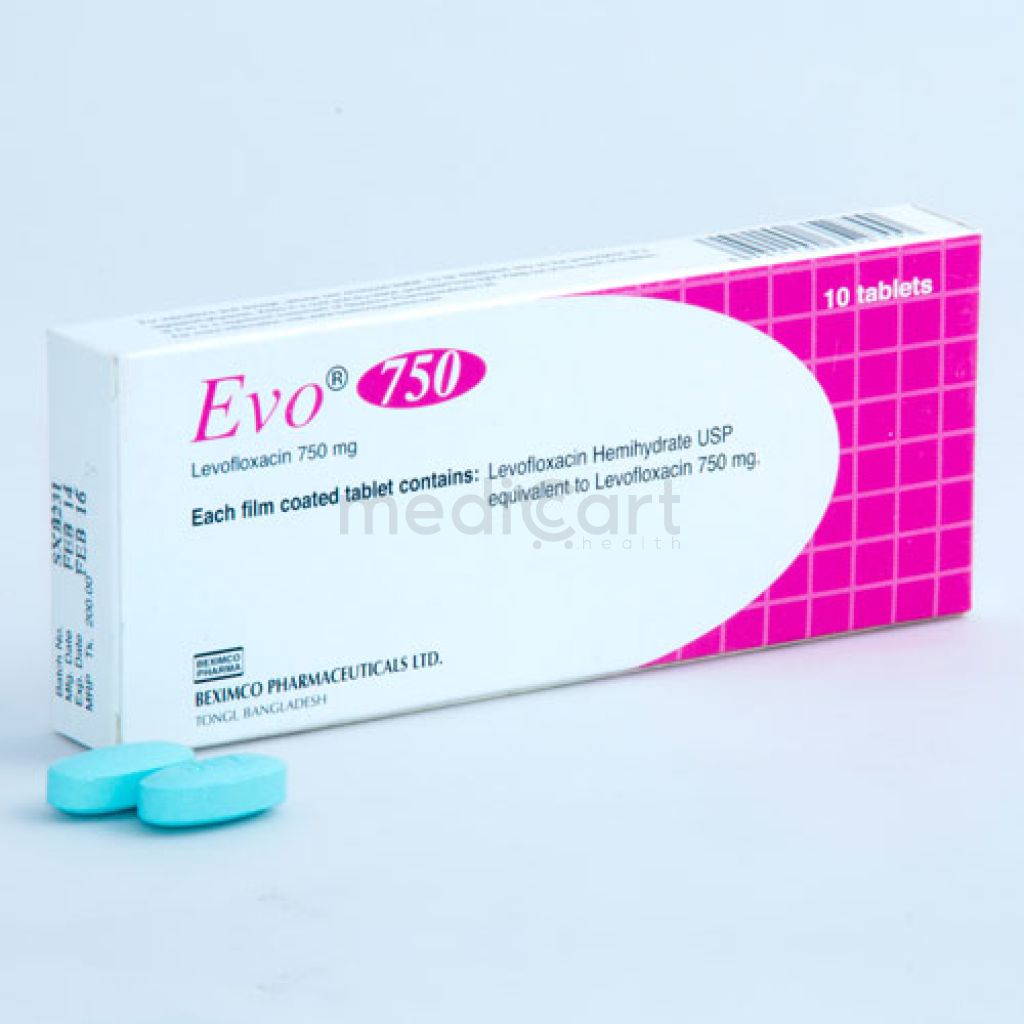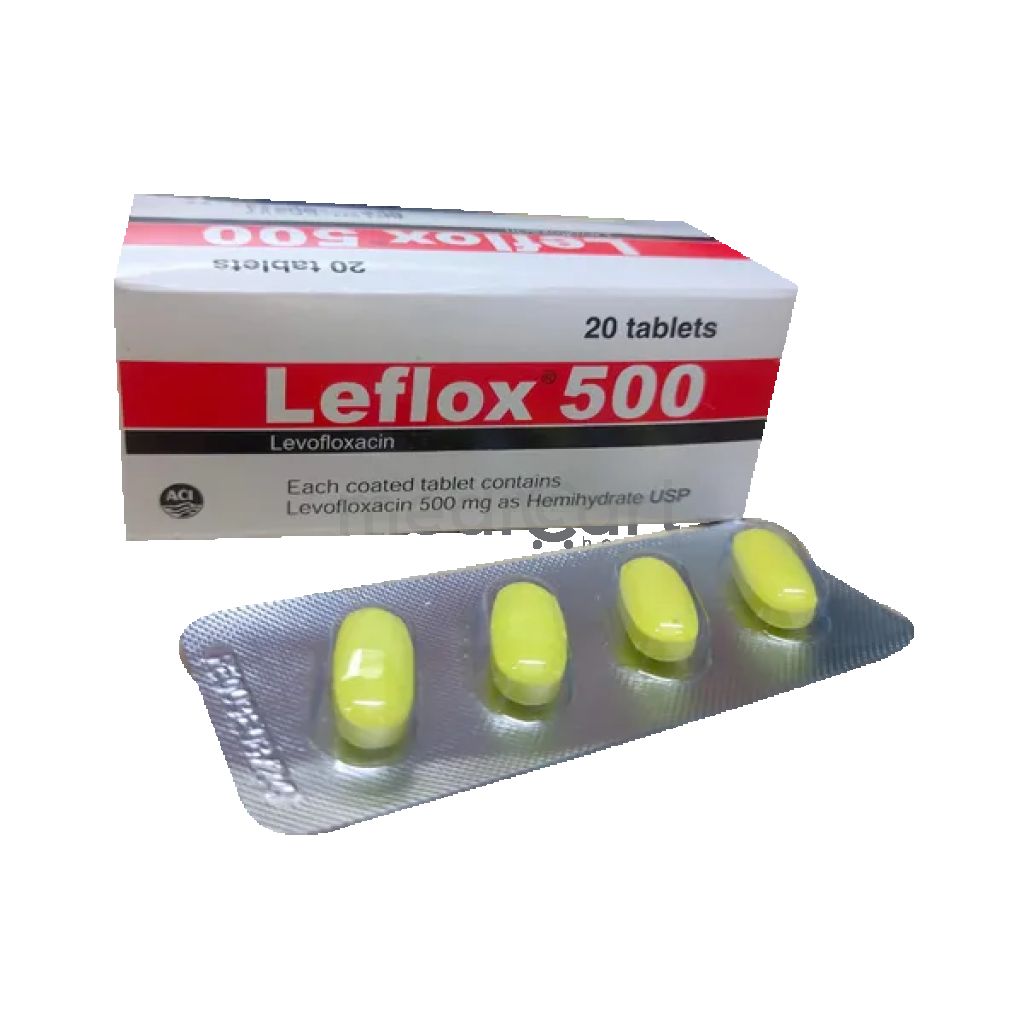

Leo 750mg
Tablet
Pack Size :
4 Tablet x 1 strip
Generics :
Levofloxacin
Manufacturer :
Acme Laboratories Ltd.
Best Price *
TK
724.32
* Delivery will be done in Dhaka city only.
Alternative Product
More Information About - Leo 750mg
Description
Generic Name
LevofloxacinPrecaution
Known or suspected CNS disorders (e.g. severe cerebral arteriosclerosis, epilepsy) or other risk factors that predispose to seizures. Avoid unnecessary exposure to sunlight or artificial UV light. History of prolonged QT interval, uncorrected electrolyte disturbances. DM (carefully monitor blood glucose levels). Periodically monitor renal, hepatic and haematopoietic functions during treatment. Pregnancy and lactation. Elderly. May impair ability to drive or operate machinery. Lactation: Drug excreted in breast milk; not recommendedIndication
Chronic bronchitis, Acute bacterial sinusitis, Anthrax, Community-acquired pneumonia, Skin and skin structure infections, Nosocomial pneumonia, Urinary tract infections, Complicated skin and skin structure infections, Acute pyelonephritis, Chronic bacterial prostatitisContra Indication
Hypersensitivity to levofloxacin or other quinolones. Child <18 yr.Dose
N/ASide Effect
1-10% Nausea (7%),Headache (6%),Diarrhea (5%),Insomnia (4%),Constipation (3%),Dizziness (3%),Dyspepsia (2%),Rash (2%),Vomiting (2%),Chest pain (1%),Dyspnea (1%),Edema (1%),Fatigue (1%),Injection-site reaction (1%),Moniliasis (1%),Pain (1%),Pruritus (1%),Vaginitis (1%) <1% Cardiac: Cardiac arrest, palpitation, ventricular tachycardia, arrhythmia Nervous system: Tremor, convulsions, paresthesia, vertigo, hypertonia, hyperkinesias, abnormal gait, somnolence, syncope Metabolic: Hypoglycemia, hyperglycemia, hyperkalemia Blood/lymphatic system: Anemia, thrombocytopenia, granulocytopenia Musculoskeletal/connective tissue: Arthralgia, tendonitis, myalgia, skeletal pain Gastrointestinal (GI): Gastritis, stomatitis, pancreatitis, esophagitis, gastroenteritis, glossitis, pseudomembranous/C difficile colitis Hepatobiliary: Abnormal hepatic function, increased hepatic enzymes, increased alkaline phosphatase Psychiatric: Anxiety, agitation, confusion, depression, hallucinations, nightmares, sleep disorder, anorexia, abnormal dreaming Other: Immune hypersensitivity reaction, acute renal failure, urticaria, phlebitis, epistaxis Potentially Fatal: Anaphylaxis.Pregnancy Category
Name : Not Classified
Description
FDA has not yet classified the drug into a specified pregnancy category.Mode of Action
Levofloxacin exerts antibacterial action by inhibiting bacterial topoisomerase IV and DNA gyrase, the enzymes required for DNA replication, transcription repair and recombination. It has in vitro activity against a wide range of gram-negative and gram-positive microorganisms.Interaction
Additive effects on QT interval prolongation w/ class IA (e.g. quinidine, procainamide) or class III (amiodarone, sotalol) antiarrhythmics, fluoxetine or imipramine. Reduced absorption w/ sucralfate, didanosine, antacids containing Mg or Al, dietary supplements containing Zn, Ca, Mg or Fe. Altered glucose levels w/ antidiabetic agents (e.g. insulin, glibenclamide). Increased risk of severe tendon disorders w/ corticosteroids. Increased risk of CNS stimulation and seizures w/ NSAIDs. Increased prothrombin time w/ warfarin.Pregnancy Category Note
Pregnancy Levofloxacin has not been shown to increase risk of major birth defects, miscarriage or adverse maternal or fetal outcomes Animal data Oral administration to pregnant rats and rabbits during organogenesis at doses up to 9.4 times and 1.1 times the maximum recommended human dose (MRHD), respectively, did not result in teratogenicity; fetal toxicity reported in the rat study, but absent at doses up to 1.2 times maximum recommended human dose Lactation Drug is present in human milk following intravenous and oral administration; there is no information regarding effects on milk production or breastfed infant; because of potential risks of serious adverse reactions, in breastfed infants, a lactating woman may consider pumping and discarding breast milk during treatment and an additional two days (five half-lives) after last dose Alternatively, advise a lactating woman that breastfeeding is not recommended during treatment and for an additional two days (five half-lives) after last doseAdult Dose
Community-Acquired Pneumonia 500 mg PO/IV once daily for 7-14 days or 750 mg PO/IV once daily for 5 days Nosocomial Pneumonia 750 mg PO/IV once daily for 7-14 days Acute Bacterial Sinusitis 500 mg PO/IV once daily for 10-14 days or 750 mg PO/IV once daily for 5 days Limitations-of-use: Reserve fluoroquinolones for patients who do not have other available treatment options for acute sinusitis Acute Bacterial Exacerbation of Chronic Bronchitis 500 mg PO/IV once daily for 7 days Limitations-of-use: Reserve fluoroquinolones for patients who do not have other available treatment options for acute bacterial exacerbation of chronic bronchitis Inhalational Anthrax Postexposure therapy 500 mg PO once daily for 60 days, beginning as soon as possible after exposure Skin/Skin Structure Infections Uncomplicated: 500 mg PO/IV once daily for 7-10 days Complicated: 750 mg PO/IV once daily for 7-14 days Chronic Bacterial Prostatitis 500 mg PO/IV once daily for 28 days Complicated Urinary Tract Infections & Acute Pyelonephritis 250 mg PO/IV once daily for 10 days or 750 mg PO/IV once daily for 5 days Uncomplicated Urinary Tract Infections 250 mg PO/IV once daily for 3 days Limitations-of-use: Reserve fluoroquinolones for patients who do not have other available treatment options for uncomplicated urinary tract infections Plague Indicated for treatment and prophylaxis of plague, including pneumonic and septicemic plague, caused by Yersinia pestis in adults and pediatric patients, aged 6 months or older 500 mg PO/IV once daily for 10-14 daysChild Dose
Children PO, IV 16 mg/kg/day div q12h up to 50 kg body weight, then 500 mg qd for postexposure anthrax prophylaxis q12h For respiratory infections: <5 y: 20 mg/kg/day q12h >5 y: 10 mg/kg/day q24hRenal Dose
Renal impairment: Haemodialysis/CAPD: Initially, 500 mg daily, then 250 mg every 48 hr. Alternatively: Initially, 750 mg daily, then 500 mg every 48 hr. CrCl (ml/min) 20-49 Initially, 500 mg daily, then 250 mg every 24 hr. Alternatively: Initially, 750 mg daily, then 750 mg every 48 hr. 10-19 Initially, 500 mg daily, then 250 mg every 48 hr. Alternatively: Initially, 750 mg daily, then 500 mg every 48 hr.Administration
Oral soln: Should be taken on an empty stomach. Take on an empty stomach 1 hr before or 2 hr after meals. Ensure adequate fluid intake. Tab: May be taken with or without food. Ensure adequate fluid intake. IV Preparation Single-use vials: Dilute in 50-100 mL D5W or NS or D5/NS solution for injection to 5 mg/mL; alternative solutions include sodium lactate, Plasma-Lyte, D5/lactated Ringer, D5/NS and potassium chloride IV Administration Give by IV infusion only, not bolus; rapid or bolus administration has been associated with hypotension and must be avoided Infuse 250-500 mg over 60 minutes or 750 mg over 90 minutesDisclaimer
The information provided herein are for informational purposes only and not intended to be a substitute for professional medical advice, diagnosis, or treatment. Please note that this information should not be treated as a replacement for physical medical consultation or advice. Great effort has been placed to provide accurate and comprehensive data. However, Medicart along with its authors and editors make no representations or warranties and specifically disclaim all liability for any medical information provided on the site. The absence of any information and/or warning to any drug shall not be considered and assumed as an implied assurance of the Company.










